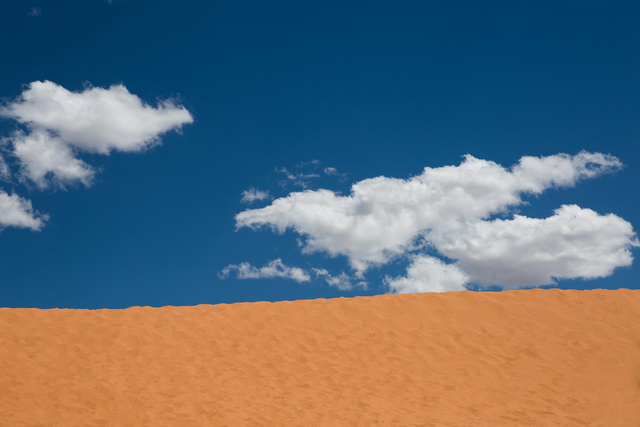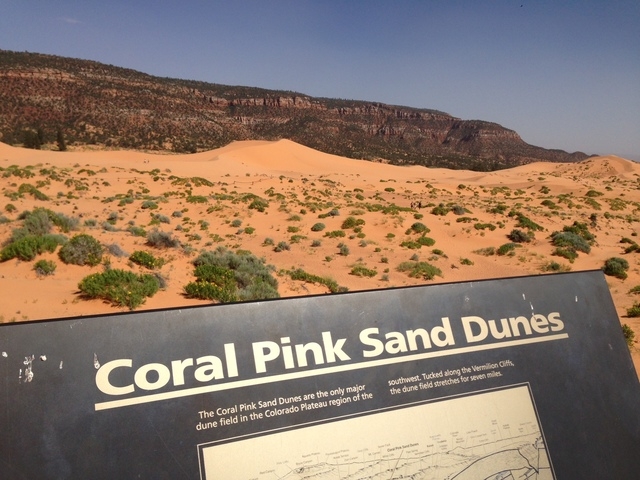Utah’s Coral Pink Sand Dunes a scenic gem


Coral Pink Sand Dunes State Park comprises a unique geological area, the gorgeous sands colored by iron oxide from the eroding Navajo sandstone found throughout Utah’s color country.
One of several sandy state parks in Southern Utah that cater to off-highway enthusiasts, Coral Pink Sand Dunes State Park is located at 6,000 feet elevation, amid tall ponderosa pines and scattered pinyons and junipers. It welcomes summer visitors with slightly cooler temperatures than in desert parks at lower elevations, and in winter there, ATV riders often course over snow-covered sand dunes.
The park lies southeast of Zion National Park and northwest of Kanab off scenic U.S. Highway 89. Drive north into Utah on Interstate 15 to reach state Route 9 a few miles north of St. George. Route 9 through Hurricane accesses two ways to Coral Pink San Dunes. The first route takes you through Zion, reaching U.S. 89 at Mount Carmel Junction, then south to meet the first of two park access roads. The route through Zion National Park requires a $25 entry fee, plus a $10 escort fee through the Zion tunnels for large RVs or vehicles towing trailers.
The second route turns onto state Route 59 in Hurricane, which becomes state Route 389 at the Arizona border and reaches Kanab and U.S. 89 through Fredonia. Coral Pink Sand Dunes State Park is 22 miles from Kanab, using Sand Dunes Road, the southern access.
Established in 1963 as a Utah state park, Coral Pink Sand Dunes preserves nearly 3,400 acres of former range land for recreation, including 2,000 acres of red sand dunes and high sand hills that move about 50 feet a year and are still growing. About 300 acres closed to motorized access protect the endangered Coral Pink tiger beetle, an insect found only in these sands, as well as some threatened plant species. This area is accessible for hiking and sand play. Popular with off-roaders, horseback riders, hikers, picnickers, campers, wildlife watchers and photographers, the park attracts visitors all year. It remains open daily with no holiday closures.
The only major dune field on the Colorado Plateau and the second highest in North America, the Coral Pink dunes are about 10,000 to 15,000 years old and several hundred feet deep. The accumulating sands arrive grain by grain, blown through a notch between the Moquith and Moccasin Mountains.
Utah collects a park entrance fee of $8 per vehicle. Near the main entrance, a tree-shaded area has five picnic sites. A boardwalk over the sands takes visitors into the area set aside for sand play. Bring beach toys, such as sand buckets and shovels, as well as slick-bottomed snow toys to slide down the dunes.
Campers use the park’s 22-site campground or the seven-unit primitive camping area maintained by the Bureau of Land Management just outside the park at Ponderosa Grove. Campsites in the park are available for $20 per night. Drive-through sites accommodate vehicles up to 40 feet. There are no hookups, but conveniences include restrooms with showers and an RV dumping station. Nature provides a free show nightly after sundown when spectacularly bright stars glitter in night skies undimmed by competing city lights.
The campground fills up fast on weekends and holidays. Reservations for campsites ensure that you will have a place to stay in the park. Reserve sites by calling 800-322-3770. For details about the park, call the visitor center at 435-648-2800.
Visitors with high-clearance vehicles can follow the park access road southwest from the state park into beautiful backcountry on the Utah-Arizona border. The area usually contains many wildflowers and cactus this time of year. The unpaved route will take you southwest to Route 59/389 between Pipe Spring National Monument and Hurricane near the border community at Colorado City, Ariz., and Hilldale, Utah.
Margo Bartlett Pesek’s column appears on Sundays.












